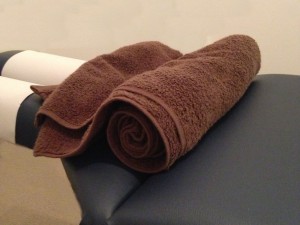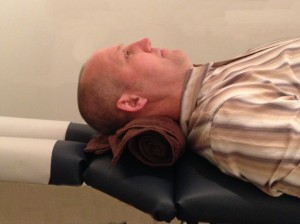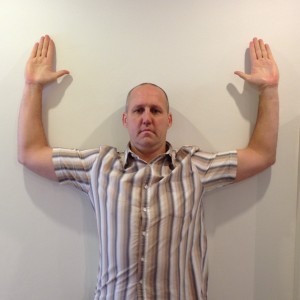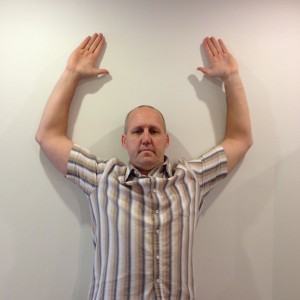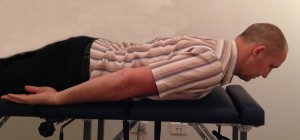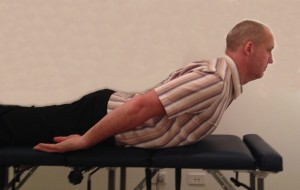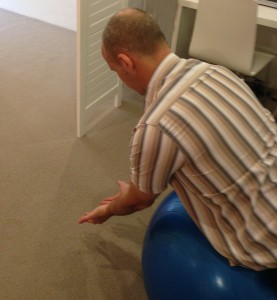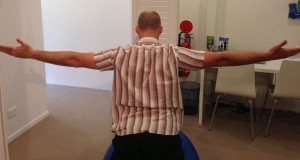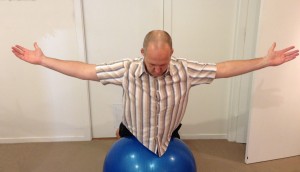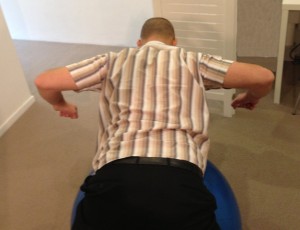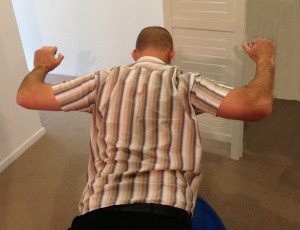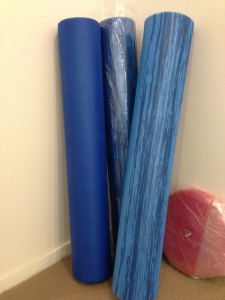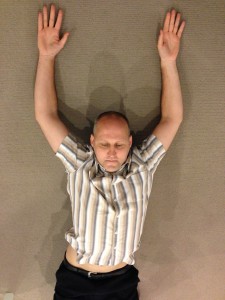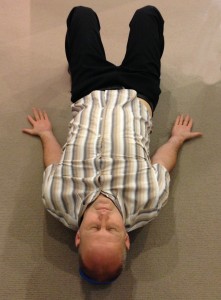How much do you use your phone during the day? Are you always texting or using your mobile device (iPad, iPhone, mobile phone) for Facebook and twittering? Does your child have a Nintendo DS or Sony PSP? Then you or your family might be starting to suffer from a condition termed as ‘text neck syndrome.’
Text neck is categorised by an overuse syndrome involving the neck and shoulders, usually resulting from excessive strain on the spine from looking forward and down for an extended period of time, such a position that is adopted when using a hand held device such as a e-reader, mobile phone, video game unit or iPad. This excessive strain on the neck muscles can cause stiffness in the neck, headaches, neck, shoulder and arm pain, breathing compromise and even early onset of osteoarthritis from excessive repetitive strain on the neck.
This texting position that people are adopting is having direct impact on the health of the individual. With the younger generation arguably more than ever reliant of hand held mobile devices, and millions of texts sent every day, this syndrome is only going to get worse. People are going to become more hunched and exhibit signs of forward head posture (FHP).
A study by Lin et al, 2009, found that texters actually hold there breath when receiving a text and showed signs of arousal, or heightened stress. This increase in sympathetic nervous system activity during texting led to a higher likelihood of experiencing pain, particularly in the neck and shoulders with 83% of participants reporting neck and shoulder pain when texting. One solution to help with neck and shoulder pain, could be simply to just breathe when sending, receiving and reading your texts.
The average human head weighs in at 5kgs, constituting around 8% of the whole body mass. Studies by Kapandji have shown that for every 2cm the neck moves forward, the weight of the head on the shoulders doubles, increasing by 100%. Therefore if the head moves forward by 6cm, the mass of your head on your shoulders would be 20kg. The effects of this FHP leads to long term muscle strains, disc herniations and pinched nerves (Mayo Clinic Health Letter, March 2000).
As the human head moves forward, there is normally a loss or flattening of the cervical lordosis (neck curve). This loss of curve leads to increased loading of the posterior joints of the spine (zygapophysial or facet joints), compression of the discs, which is one of the major contributing factors in early osteoarthritis. (Roentgenographic findings of the cervical spine in asymptomatic people, Spine, 1986;6:591-694). Dr Alf Breig, a noble prize recipient and neurosurgeon stated that ‘a loss of the cervical curve, will lead to stretching the spinal cord by 5-7cm and will cause disease.
FHP has been shown to decrease the total vital capacity of the lungs by 30 percent. This shortness of breath will lead to heart and blood vascular diseases. It also impacts on the gastrointestinal system, especially the large intestine. Loss of good bowel movements and evacuation are a common effect of FHP due to the compression that is occurring and normally the interference to the nervous system, usually at the upper cervical spine.
Dr Roger Sperry, a nobel prize recipient for brain research demonstrated that 90% of the stimulation and nutrition of the brain is generated from spinal movement. He showed that 90 percent of the energy output of the brain is in relation to the effects of gravity on the body. That leaves us only with 10 percent for thinking, metabolism, and healing. So when you place your head forward and adopt this FHP position, you potentially rob your brain from thinking, metabolising and immunity, so it can concentrate on dealing with this abnormal gravity/posture relationship that is happening.
So what can be done if you are already starting to show signs and symptoms of a text neck?
1. First and foremost is to become aware of your posture when using these mobile devices. Watch how you sit and mininise the amount of time looking down.
2. Take regular breaks. My general rule is to hold the device at eye level, and when the arms get tired from holding it up, then it is time to take a break. This probably means a little more regular than what you are now doing.
3. If you have an android device, a chiropractor in America, Dr Fishman has come up with an app for helping keep posture, called text neck. It costs around $2.99 but can be a good way of helping you train to use your mobile device more ergonomically.
Exercises to help relieve the effects of text neck:
1. Cervical/NeckTowel. This can be one of the most beneficial things you can do for your neck. Due to the posture of looking down, we flatten or even reverse our neck curve, which in turn affects the suspension system in our necks (discs). This simple exercise of laying on a rolled towel under your neck for 10 minutes per day can help recover that lost curve and suspension system.
2. Snow/Wall Angels. Stand with your back, heels and the back of your head against the wall. Now bring your arms as far back to the wall as possible, so now that both arms are at a 90 degree angle. Lock your shoulder blades back and down and try to lift/slide your arms up the wall so they go over your head, whilst never allowing them to lift off the wall. Once they are overhead, bring the arms down in the same fashion as up till they are by your sides. Never allow your arms to leave the wall and always keep your shoulders back and down. The movement needs to be slow and deliberate and repeated 12 times.
3. Prone Neck Extension. Laying face down on the floor, with your arms by your side, lock the shoulders back and down. Slowly lift your head up and start looking at the ceiling diagonally forward. With the same continuous motion, now try and lift your shoulders, and then your chest, all the while maintaining your shoulders back and down. Hold this position for 10 seconds, then deliberately lower the chest, then the shoulders and then the head, as if it were done in slow motion. Repeat this motion for 10 repetitions.
4. Prone Arm Abduction. Whilst laying face down on an exercise ball (if you don’t have an exercise ball, it can be performed on the floor but a ball is ideal) with your head and chest just off the ball. Now lock your shoulders back and down as you have down before. With your arms resting forward, turn your thumbs so they start facing out and up towards the ceiling (hand supination), and slowly lift your arms out to the side, so your body resembles a ‘T’. Then slowly return them back to the floor and the starting position, all the while maintaining the shoulder blade position of back and down. Repeat this 12 times.
5. Prone Arm 90/90. Again whilst laying on the exercise ball in same position as above, lock your shoulder blades back and down. This time the arms should be held in a down position with the thumbs facing in (hand pronation). Now bend the elbows to 90 degrees whilst lifting the arms out to the side and then rotate the arms backwards. Next rotate the arms forward to the starting position, and then bring the arms back to the floor, all the while maintaining that shoulder position of back and down. Again the movement needs to be slow and deliberate and perform for 12 repetitions.
6. Posture Pole/Pilates Foam Roller. If you have access to these hard cylindrical foam rollers, they can be great at helping achieve a better posture and stop that hunchback developing. They help to achieve a great stretch of the muscles on the anterior (front of our shoulders and our chest). The muscles that we constantly use and tighten throughout the day, as everything is done in front of us and never behind. Lay on the roller lengthways with head one end and your buttock the other. Now place your arms directly above your head, with palms up and hold this position for 30 seconds. Now bend your elbows and bring your hands down to next your head. Again hold for 30 seconds. Lastly bring your hands so they are next to your hips with the palms up, and hold for 30 seconds. This should repeated initially twice and it can be built up to 10 minutes on the roller three times a week. If your hands can touch the floor, try and let them relax there otherwise don’t worry with time and practice your arms and hands might be able to achieve this. If at any time you feel more than just a stretch and have pain or tingling and numbness, stop the exercise and consult your healthcare practitioner.
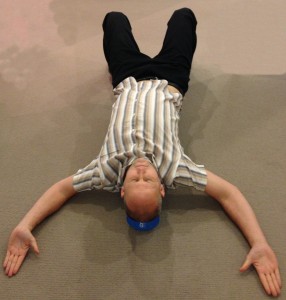
7. Bruggards Postural Relief. Whilst in a sitting position, sit tall with the shoulder blades back and down. Next hold your elbows by your side with the elbows bent 90 degrees. Now slowly externally rotate your hands away from your body, whilst maintaining your elbows by your side and your shoulder blades back and down. When you cannot turn your hands out any more, open your fingers as wide as they can go to stretch your fingers. Also whilst turning your hands out slowly retract your neck backwards (almost creating that double chin effect) to help strengthen your deep neck flexors. Perform all movements slowly, deliberately and perform 12 repetitions.
If you have questions or you think you might have ‘text neck’ contact the team at Neurohealth Chiropractic to discuss the options that can be beneficial to you.
If you would like more information or would like to book an appointment at Neurohealth Chiropractic – please call the clinic on 9905 9099 or email us admin@neurohealthchiro.com.au or fill in the contact form from our website www.neurohealthchiro.com.au
Sign up to receive Neurohealth Chiropractic’s Free monthly health newsletter on the Right Hand Side of this page. Filled with great information and lots of easy health tips to keep you at Optimal Health!
This article is written by Dr. Steven Cannon, Chiropractor – Neurohealth Chiropractic


